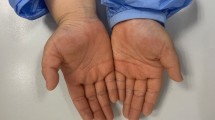Abstract
At least 30 % of children with chronic urticaria have an autoimmune aetiology with a positive autologous serum skin test (ASST). ASST is cheap, easy to perform and has good sensibility and specificity in detecting autoantibodies. In case of concern about reliability of ASST because of antihistamine medications, test transferability seems to be feasible.
Similar content being viewed by others
Avoid common mistakes on your manuscript.
A 13-year-old female presented with a 4-month history of worsening urticaria frequently associated with angioedema and hardly controlled by high doses of antihistamine (10 mg daily). Urticaria did not seem to be triggered by physical stimuli.
Specific IgE against common foods and aeroallergens were negative; full blood count, C3 and C4 complement fractions, ESR and thyroid function were normal. Main autoantibodies were absent. Since every attempt to slow down the antihistamine dosage had led to immediate and severe urticaria/angioedema relapse, we decided to perform an intradermal injection of the patient's serum also in her own mother. After 15 min, a little weal appeared on the patient's forearm, and a large weal appeared on her mother (Fig. 1). We diagnosed chronic autoimmune urticaria (CAU).
Overall, 0.1–3 % of children are diagnosed with chronic urticaria (CU) [2]. In nearly 30 % of patients with CU, active autoantibodies against IgE or its receptor have been identified [2, 3]. The autologous serum skin test is an in vivo clinical test which has been suggested as a screening tool for CAU [2, 3]. Interestingly, despite full antihistamine therapy, the patient test resulted positive, although much less pronounced. This incomplete test inhibition by antihistamine therapy has already been reported in the literature [1].
References
Asero R, Tedeschi A, Lorini M, Cugno M (2009) Antihistamines do not inhibit the flare induced by the intradermal injection of autologous plasma in chronic urticaria patients. Eur Ann Allergy Clin Immunol 41(6):181–186
Brunetti L, Francavilla R, Miniello VL et al (2004) High prevalence of autoimmune urticaria in children with chronic urticaria. J Allergy Clin Immunol 114(4):922–927
Zitelli KB, Cordoro KM (2011) Evidence-based evaluation and management of chronic urticaria in children. Pediatr Dermatol 28(6):629–639
Conflict of interest
None to declare.
Author information
Authors and Affiliations
Corresponding author
Rights and permissions
About this article
Cite this article
Pastore, S., Berti, I. & Longo, G. Autoimmune chronic urticaria: transferability of autologous serum skin test. Eur J Pediatr 172, 569 (2013). https://doi.org/10.1007/s00431-013-1936-4
Received:
Accepted:
Published:
Issue Date:
DOI: https://doi.org/10.1007/s00431-013-1936-4





